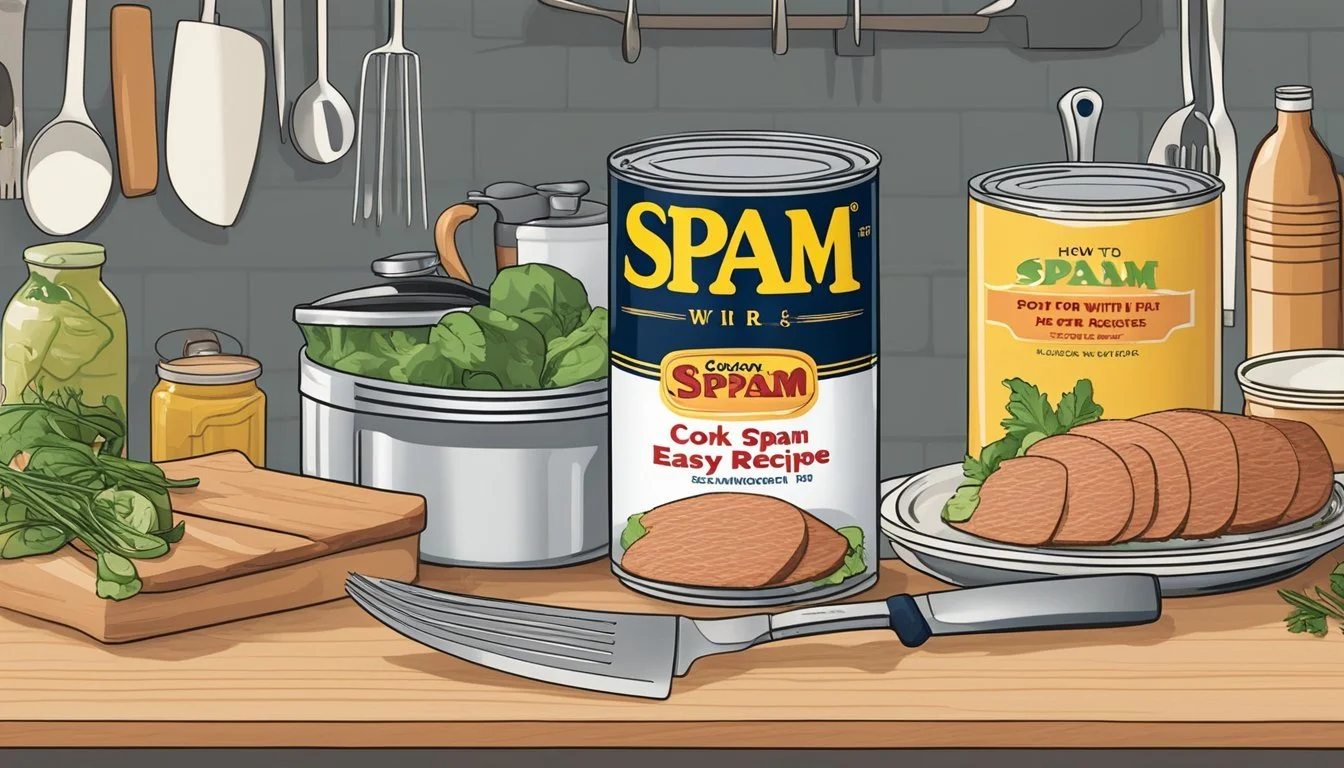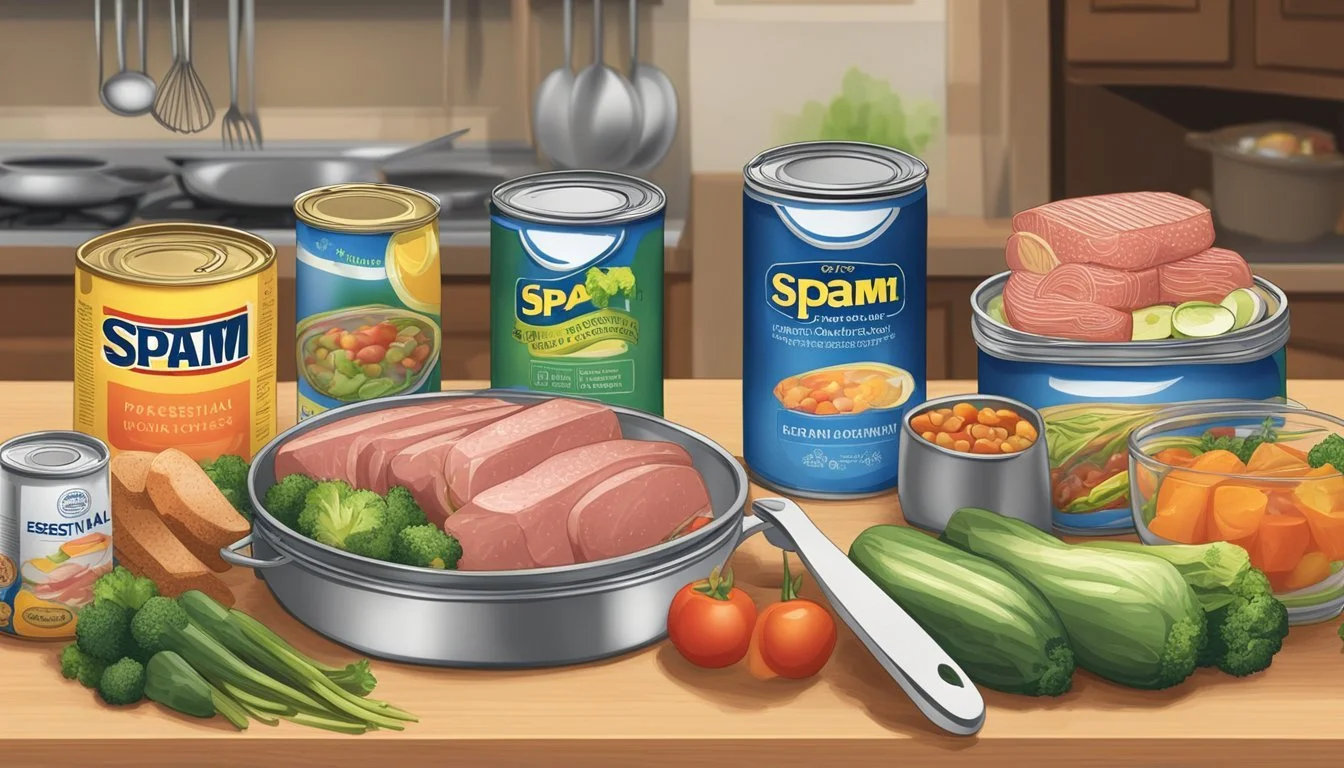How to Cook with Spam for Easy, Savory Recipes
A Guide to Quick and Flavorful Meals
Spam, the versatile canned meat made of pork with ham, has been a staple in pantries around the world since the 1930s. Its convenience and long shelf life make it an ideal ingredient for quick and savory meals. As it comes fully cooked, it can be sliced, diced, and added to a variety of recipes without extensive preparation. Its salty flavor and firm texture lend themselves to be easily incorporated into dishes ranging from simple sandwiches to more elaborate culinary creations.
Cooking with Spam opens up a realm of possibilities for both experienced cooks and those new to the kitchen. It can replace bacon or ham in dishes like tacos, burgers, and stir-fries, offering a unique taste that can enhance the overall flavor profile. Those looking to craft easy and savory dishes can experiment with Spam by adding it to soups, such as the Korean-American fusion dish Budae Jjigae, also known as Army Stew, which harmoniously combines Spam with ingredients like kimchi, tofu, and mushrooms in a spicy broth.
The simplicity of preparing Spam is appealing; it can be fried to a golden caramelized finish, wrapped in bacon for a smoky twist, or even layered with rice and nori to make Spam musubi, a popular Hawaiian snack. Whether one is looking to whip up a quick family dinner (What wine goes well with dinner?) or explore new culinary territories, Spam proves to be an adaptable companion in the kitchen, providing a boost of protein and flavor to countless recipes.
The History and Popularity of Spam
Spam, a canned precooked meat product, was introduced by Hormel Foods Corporation in 1937. It gained prominence during World War II when it was used to feed soldiers, becoming a staple due to its longevity and ease of transportation. After the war, Spam found its way into the kitchens of ordinary American households, marking its rise as a versatile ingredient.
In Hawaii, Spam has a unique and beloved place. It was introduced to the islands during World War II and has since become embedded in Hawaiian culture. Hawaii consumes more Spam per capita than any other state in the U.S., incorporating it into Hawaiian comfort food and celebrations. The most notable dish that features Spam is Spam musubi, a slice of grilled Spam atop a block of rice, wrapped in seaweed.
The product's success hinges on its versatility and convenience. Over the years, Spam has become a global phenomenon, enjoying popularity in various countries as a reliable source of protein that can be easily stored and prepared. Its use in a range of recipes, from traditional dishes to innovative culinary experiments, has maintained its status not just as a wartime ration but as a pantry staple.
Fact Detail Origins Launched in 1937 by Hormel Foods Corporation. Wartime Significance Fed soldiers during World War II. Cultural Impact in Hawaii Integral to Hawaiian cuisine and culture. Global Reach Popular worldwide as a convenient, versatile meat product.
With a rich history and widespread popularity, Spam continues to hold its place at the table as both a comfort food and a subject of culinary creativity.
Types of Spam Products and Selection Tips
When shopping for Spam, consumers will find a variety of flavors and formulations to suit different tastes and dietary preferences. Classic Spam remains the staple product, made predominantly from pork shoulder and ham, and has a distinct salty, savory profile suitable for various recipes.
Spam Lite is crafted for those seeking a lower fat option, containing fewer calories and less sodium than the original. This variety still retains the protein content which is essential for a nutritious meal, making it a smart choice for health-conscious individuals.
For a smoky twist, Spam with Bacon introduces the rich taste of bacon to the traditional Spam formula. This variety incorporates bacon and ham, offering a deeper flavor that works particularly well in breakfast dishes or to elevate comfort foods.
Here is a brief selection guide for choosing the right Spam product:
Spam Type Best For Notes Classic Spam General Cooking and Musubi High in protein; very versatile Spam Lite Healthier Recipes Less fat and sodium Spam with Bacon Flavorful, Hearty Meals Adds a smoky bacon taste
When selecting your Spam product, always check the expiration date to ensure freshness. It's also wise to consider the sodium content, especially if dietary restrictions are a concern. Lastly, one should choose based on the intended recipe to make sure the flavor complements the other ingredients in the dish.
Essential Ingredients for Spam Recipes
When venturing into cooking with Spam, certain ingredients are key to elevating its savory qualities.
Firstly, Spam itself is a given, with its unique salty and pork-based flavor profile which can be used right out of the can, or fried to a crisp—depending on the recipe's demand. To complement this, soy sauce is an excellent addition. It not only deepens the umami flavor but also adds a rich, savory note that is distinguishable in many Asian-inspired Spam dishes.
Garlic is another ingredient that's almost indispensable. Fresh minced garlic or garlic powder brings out a pungent aromatic that works in harmony with Spam’s salinity.
For basic seasoning, a dash of salt and pepper is often enough to enhance the natural flavors of the dishes. However, with Spam’s inherent saltiness, chefs should use additional salt judiciously.
Below is a brief list of essential ingredients to keep on hand:
Spam (Primary Ingredient)
Soy Sauce (For Umami Flavor)
Garlic (Minced or Powdered)
Seasoning:
Salt (Use sparingly)
Additional Seasonings (if preferred):
Onion Powder
Paprika
Red Pepper Flakes
Collectively, these ingredients form the cornerstone of most Spam recipes, whether the dish leans towards the simple and comforting or the rich and complex. Each plays a role in delivering the full savory potential of Spam in a culinary context. With these in the pantry, cooks can confidently tackle a wide range of Spam-based recipes.
Preparing the Kitchen and Spam
Before you start cooking with Spam, it is essential to prepare both your kitchen workspace and the Spam itself properly to ensure a hygienic and efficient cooking experience.
Materials You'll Need:
Sharp knife
Can opener
Skillet or frying pan (preferably non-stick or cast-iron)
Cookware Preparation:
One should ensure that the skillet or frying pan is clean and placed on the stove. For non-stick pans, the use of oil is optional, but for cast iron, if it is well-seasoned, additional oil is not necessary.
Spam Preparation:
Begin by opening the Spam can with a can opener.
Carefully remove the Spam from the can and place it on the cutting board.
With the sharp knife, slice the Spam into even pieces, typically 8 slices per can unless a different thickness is desired for the recipe.
To prevent sticking, one can lightly coat the slices with a thin layer of cooking oil if their pan isn't non-stick or well-seasoned.
Clean Up:
Maintaining cleanliness is crucial. One should clean any spillages immediately and keep the work surface tidy to avoid cross-contamination.
By following these steps, the kitchen and Spam will be well-prepared, creating a conducive environment for cooking a variety of Spam-based dishes.
Classic Spam Recipes
Spam has cemented its place in kitchen pantries for its versatility and ease of preparation. When it comes to classic Spam recipes, three standout dishes are Hawaiian Spam Musubi, Traditional Spam Fried Rice, and Simple Spiced Spam Tacos, each offering a unique, delicious taste of this iconic canned meat.
Hawaiian Spam Musubi
This iconic snack, beloved in Hawaii, transforms Spam into a sushi (What wine goes well with sushi?)-like treat. The user slices Spam and sears it until crisp. It's then placed on a block of seasoned sticky rice and wrapped in a strip of nori, resulting in a portable and savory bite that is both satisfying and uniquely delicious.
Traditional Spam Fried Rice
In this hearty dish, chunks of Spam are stir-fried with day-old rice, vegetables, and soy sauce to create a flavorful and satisfying meal. Eggs are often scrambled into the rice to add richness, and a sprinkle of green onions (What wine goes well with onions?) provides a fresh, sharp contrast to the salty Spam.
Simple Spiced Spam Tacos
A fusion twist on tacos, Spam is cut into cubes and cooked until golden. These crispy Spam bits are then loaded into taco shells and garnished with traditional toppings like lettuce, cheese, salsa, and sour cream. A sprinkle of spice mix gives the tacos an extra layer of flavor.
Creative Spam Twists
Exploring innovative ways to integrate Spam into classic dishes can offer a delightful surprise to the palate. These twists not only provide a savory punch but also add an unexpected texture and flavor profile to familiar meals.
Caramelized Spam and Eggs
Transforming the humble Spam and eggs into a delectable gourmet-like dish starts with caramelization. Caramelized Spam and Eggs take a classic breakfast to the next level. The key is to slice the Spam thinly and fry until a golden-brown crust forms, offering a sweet and salty contrast. Served over a bed of fluffy scrambled eggs, this combination melds together for a satisfying morning twist.
Spam Kimchi Pizza
Spam Kimchi Pizza is a fusion that captures the essence of Korean flavors on a traditional Italian canvas. To craft this dish, spread kimchi sauce over pizza dough and top with chopped Spam, mozzarella cheese, and additional garnishes like green onions. The kimchi brings vibrant spiciness which perfectly complements the meaty Spam, while the melted cheese ties all components together for a harmonious bite.
Spam and Cheese Waffles
Reinventing waffles by incorporating Spam and cheese results in a savory snack that is both indulgent and comforting. Spam and Cheese Waffles are a playful savory twist on a breakfast staple. For this recipe, diced Spam and shredded cheese are folded into the waffle batter, creating pockets of meaty and cheesy goodness in every slice. These waffles can be served with a dip or simply enjoyed hot and fresh from the iron.
Inclusion of Spam into these dishes provides a unique twist, making each recipe a conversation starter and an adventurous addition to any meal repertoire.
International Spam-Inspired Dishes
Spam, the versatile canned meat product, is a popular ingredient in various international cuisines. It is especially prominent in Asian recipes where it adds a savory depth to rice and noodle dishes.
Spam Ramen Fusion
Spam adds a unique twist to traditional Asian ramen dishes. To create Spam Ramen Fusion, one begins by pan-frying slices of Spam until they are crispy. These slices are then added to a bowl of steaming ramen noodles, complementing the rich, savory broth. Toppings can include nori strips, a soft-boiled egg, and green onions for a quick and comforting meal.
Ingredients:
Crispy Spam slices
Ramen noodles
Broth (chicken, beef, or dashi)
Toppings: nori, soft-boiled egg, green onions
Spam Onigirazu Sushi
Spam Onigirazu, a modern take on sushi, involves wrapping a crispy slice of Spam with sushi rice and nori seaweed. This variation often includes additional fillings such as scrambled eggs, pickled radish, or avocado. The onigirazu is then cut into halves, showcasing the layers of ingredients and offering a portable and satisfying meal.
Components:
Sushi rice
Nori sheets
Spam slices, cooked until crispy
Fillings (optional): eggs, pickled radish, avocado
Korean Budae Jjigae with Spam
Korean Budae Jjigae, or Army Stew, incorporates Spam into a hot, spicy broth filled with diverse ingredients. The dish is a fusion born out of necessity, combining Korean flavors with American processed meats. The stew typically includes tofu, mushrooms, Spam, and sometimes additional meats like hot dogs and bacon. It delivers a hearty, spicy, and savory flavor experience.
Key Ingredients:
Spam
Tofu
Mushrooms
Various meats (hot dogs, bacon)
Broth Seasonings:
Gochujang (Korean red pepper paste)
Soy sauce
Garlic
Healthy Options with Spam
When cooking with Spam, one can balance its richness by pairing it with fresh vegetables and healthier cooking methods. By incorporating nutrient-dense ingredients like spinach, and using techniques like baking and stir-frying, one can create healthier Spam-based meals that provide both protein and a variety of vitamins.
Spam and Vegetable Stir Fry
A Spam and vegetable stir fry makes for a nutritious and quick meal. To start, one should cut the Spam into cubes or thin slices and brown them in a non-stick pan with minimal oil. Then, one can add an assortment of colorful vegetables such as bell peppers, broccoli, carrots, and snap peas. Stir-frying over high heat for a short duration ensures that the vegetables retain their nutrients and crisp texture. For seasoning, a splash of low-sodium soy sauce and a sprinkle of garlic can enhance the flavors while keeping things health-conscious.
Ingredients:
Spam: Cubed or sliced
Vegetables: Bell peppers, broccoli, carrots, snap peas
Seasoning: Low-sodium soy sauce, minced garlic
Steps:
Brown the Spam in a non-stick pan.
Add the chopped vegetables.
Season and stir-fry quickly over high heat.
Baked Spam and Spinach Casserole
Baked dishes offer a healthier approach to cooking Spam. One such recipe is the baked Spam and spinach casserole. In this dish, lean cuts of Spam are layered with fresh or frozen spinach — a power-packed vegetable rich in iron and vitamins. For binding, one could use a mixture of low-fat milk and eggs, and then top it with a sprinkle of low-fat cheese, to add calcium without excessive calories. This casserole can be baked until it's set and the top is golden brown, creating a comforting yet healthier Spam meal.
Ingredients:
Spam: Lean cuts
Spinach: Fresh or frozen
Binder: Low-fat milk, eggs
Topping: Low-fat cheese
Steps:
Layer the lean Spam and spinach in a baking dish.
Pour a mixture of low-fat milk and beaten eggs over the layers.
Top with low-fat cheese and bake until golden.
Cooking Techniques for Spam
Spam, known for its versatility and ease of preparation, shines across various cooking methods. The following techniques highlight how to achieve different flavors and textures, from crispy slices to juicy chunks that can enhance dishes like fried rice or serve as a standalone treat.
Frying and Sautéing Spam
Frying Spam is a quick way to develop a caramelized surface while maintaining a tender interior. A chef can:
Slice the Spam into uniform pieces, about 1/4 inch thick for an even cook.
Heat a skillet over medium-high heat and place the slices in the hot pan without overcrowding.
Cook for 3 to 5 minutes on each side until the desired crispiness is achieved.
Sautéing is similar but often involves cutting Spam into smaller cubes or strips, perfect for mixing into dishes like fried rice. One should:
Cube the Spam to bite-sized pieces to ensure it crisps on all sides.
Stir-fry in a bit of oil, tossing frequently for an even sauté.
Baking and Roasting Spam
Baking Spam in an oven preheated to 350°F can result in evenly cooked pieces that are slightly less crispy but still savory.
Arrange slices of Spam on a baking sheet and bake for around 20 minutes.
Flip them halfway through for uniform heating.
Roasting Spam at a higher temperature can intensify flavors and is especially suitable for larger chunks.
Preheat the oven to a higher temperature, such as 400°F.
Roast chunked Spam for 15-20 minutes, checking frequently to prevent burning.
Grilling and Air Frying Spam
Grilling gives Spam a smoky flavor and distinct grill marks.
Preheat the grill to medium-high and place Spam slices directly on the grill.
Grill each side for 2-3 minutes, monitoring to avoid excessive charring.
Air frying has become a popular method for achieving a crispy texture with less oil.
An air fryer set to 375°F can cook Spam fries in about 8 minutes.
One should turn the Spam halfway through to ensure even cooking.
By mastering these techniques, one can incorporate Spam into a myriad of recipes, capitalizing on its unique taste and textural contributions.
Serving and Garnishing Spam Dishes
When presenting Spam dishes, one aims for a balance between visual appeal and complementary flavors. A well-garnished Spam dish not only looks inviting but also enhances the overall taste experience.
For an Asian Twist:
Green onions: Finely chopped green onions add a fresh, sharp contrast.
Sesame oil: A drizzle of sesame oil can give the dish a nutty aroma.
Teriyaki sauce: Brushing Spam with teriyaki sauce during the cooking process can caramelize the surface, adding a sweet and savory glaze.
To Add Heat:
Chili: Fresh or dried chili can introduce a spicy kick, perfect for those who appreciate a bit of heat.
Spam Musubi: Top this sushi-style snack with a thin strip of nori and a brush of soy sauce, with a sprinkle of sesame seeds for texture.
Oyster sauce: A small amount of oyster sauce can lend a deep, savory umami flavor.
Garnishing and Serving Tips:
Balance flavors: Ensure that the garnishes complement the main ingredient without overwhelming it.
Texture contrast: Crispy fried Spam pairs well with soft garnishes like sliced green onions.
Use garnishes sparingly: Too much can detract from the main dish.
By adhering to these guidelines, one ensures that Spam's versatility shines in a range of dishes, providing a delightful eating experience for all.
Pairings and Sides for Spam Dishes
When creating a meal with Spam, selecting the appropriate pairings and sides can elevate the dish from simple to sophisticated. A variety of side dishes complement the distinct flavor of Spam, turning it into a satisfying meal.
Rice Recipes: Spam pairs exceptionally well with rice, a staple that balances the meat's saltiness. Fried rice is an excellent choice, combining vegetables, soy sauce, and sesame oil to add depth. To indulge in a Hawaiian favorite, consider Spam musubi—slices of Spam on a block of rice, wrapped in nori.
Vegetables: The key to pairing Spam with vegetables is to choose those that can stand up to its boldness. Stir-fried or steamed, vegetables like broccoli, bell peppers, and snap peas add a necessary crunch and nutritional value.
Slaw: A refreshing contrast to the heavy nature of Spam, slaws provide a tangy and crisp side option. A classic coleslaw or a pineapple slaw introduces a sweet and sour element that cuts through the richness of the meat.
Side Dish Type Examples Rice Fried rice, Spam musubi Vegetables Stir-fried veggies, steamed broccoli Slaw Coleslaw, pineapple slaw
By incorporating these sides, each Spam dish can be transformed into a well-rounded meal. The key is to maintain balance, ensuring that the flavors of each component complement rather than overshadow the unique taste of Spam.
Preserving and Storing Spam
When it comes to preserving Spam, proper storage is essential to maintain its shelf-life and quality. Unopened cans of Spam can last several years when stored in a cool, dry place. Once opened, Spam should be kept in an airtight container in the refrigerator to prevent spoilage.
Unopened Cans Storage:
Keep in a cool, dry place away from direct sunlight.
Check the expiration date for shelf-life estimation.
After Opening:
Transfer contents to an airtight container.
Refrigerate at 40°F (4°C) or below.
Consume within 3 to 5 days for optimal freshness.
Leftovers of Spam should be treated with the same care. If the cooked Spam won't be consumed immediately, it should be refrigerated within two hours of cooking. Place the leftovers in an airtight container to avoid cross-contamination with other foods and to retain the flavor and texture of the Spam.
For those interested in long-term storage, here is a brief guide to canning cooked Spam:
Cook the Spam: Fully cook before canning to ensure safety.
Prepare Jars: Sterilize jars by boiling them.
Canning Process:
Fill jars with cooked Spam, leaving some headspace.
Seal jars with lids and process them in a pressure canner.
By adhering to these measures, one ensures the preserved quality of Spam for future meals, maintaining its savory taste and extending its usability.
Tips and Tricks for Enhancing Spam Flavor
Spam, a pre-cooked meat product, often benefits from additional flavors to enhance its savory quality. Here are some effective ways to do so:
Seasoning: Incorporating a blend of seasonings can elevate Spam's taste. Consider garlic powder, onion powder, or a dash of paprika to introduce complexity to its flavor profile.
Sugar Balance: Adding a bit of sugar during cooking can contrast Spam's saltiness, creating a delightful balance. It caramelizes when fried, lending a subtle sweetness and a more appealing crust to the slices.
Sesame Oil: For an Asian twist, chefs may add a few drops of sesame oil. Its nutty essence complements Spam's richness. Use it sparingly; the oil's strong flavor goes a long way.
Butter Magic: Frying Spam in butter not only prevents sticking but also infuses it with a creamy taste that smooths out its processed tang. Prefer unsalted butter to manage the dish's overall saltiness.
Quick Ideas:
Stir-Fry: Fry the diced Spam until crispy, then toss with vegetables and a splash of soy sauce.
Musubi Magic: Layer a slice of Spam between rice and nori, adding a soy sauce glaze for classic Hawaiian musubi.
Simple Fry-Up: Pan-fry Spam slices until golden and caramelize with a glaze of teriyaki or a sprinkle of brown sugar.
These tips help anyone harness the full potential of Spam, transforming this humble canned meat into a versatile ingredient for numerous savory dishes.
Versatility of Spam in Various Cuisines
Spam, the canned meat product, has found its place in kitchens across the globe, showcasing remarkable versatility. In Asian cuisine, Spam is a staple ingredient that can transform simple recipes into comforting meals. It can be fried and paired with rice, enveloped within sushi rice and nori to create Spam musubi, or even included in stir-fries for added protein.
In Mexican cooking, Spam can be diced and included in tacos or burritos, offering a savory twist to these classic dishes. It can also be grilled and served alongside traditional condiments like salsa and avocado, effortlessly melding with the zestful flavors of Mexican gastronomy.
Fusion recipes that incorporate Spam bridge the gap between diverse culinary traditions. For instance, Spam can be added to Korean bibimbap, embracing the dish's inherent fusion-like nature by bringing in a salty, hearty element. Likewise, it can contemporize an Italian carbonara, introducing a new layer of flavor to a well-loved classic.
Ingredients and Preparation Techniques:
Asian Recipe (Easy): Fry slices of Spam and include them in fried rice with vegetables.
Mexican: Cube Spam and mix with beans, cheese, and spices for a filling quesadilla.
Fusion Recipe: Use Spam in place of bacon to create a Hawaiian pizza with a tropical twist.
Overall, Spam's inclusion in these varied cuisines highlights its adaptability and the ease with which it can be integrated into multiple culinary contexts.
Utilizing Leftovers: Spam Reworked
Spam, the versatile canned meat, can be creatively incorporated into a variety of dishes that breathe new life into leftovers. With its bold flavor and easy-to-cook nature, it's perfect for transforming day-old rice or last night's side dishes into a whole new experience.
Spam Fried Rice: A classic way to utilize leftover rice and vegetables. Cook cubed Spam in a pan until lightly browned, then add a mix of vegetables like peas, carrots, and onions. Stir in the day-old rice, season with soy sauce, and scramble in an egg for a complete one-pan meal.
Spam Casserole: Casseroles (What wine goes well with casseroles?) are ideal for combining various leftovers into a hearty dish. Layer slices of Spam between leftovers like mashed potatoes and any available veggies. Top the assembly with a layer of cheese and bake until bubbly and golden.
Recipe Ideas:
Spam Burritos: Fill tortillas with a combination of diced Spam, leftover beans, rice, and cheese. Roll them tightly and bake seam side down to create a crispy exterior. Serve with salsa or guacamole for added zest.
Spam Musubi: A fun and portable snack, layer a slice of Spam onto pressed rice and wrap with nori. It's perfect for using up the last bits of rice and adds a delightful savory touch.
Here's a simple recipe card for turning leftovers into a satisfying Spam dish:
Spam Transformation Recipe
Ingredients
- 1 can of Spam, cubed
- 2 cups day-old rice
- 1 cup mixed vegetables
- 2 tbsp soy sauce
- Optional: 1 beaten egg, nori strips, tortillas, cheese
Instructions
1. For fried rice or burritos, sauté Spam until golden.
2. Add vegetables (and rice for fried rice), cooking until heated through.
3. Season with soy sauce (and add beaten egg for fried rice), mixing well.
4. For burritos, wrap ingredients in tortillas and bake.
5. For musubi, layer rice and Spam on nori strip, roll, and slice.Cooking with Spam is a practice in creativity, taking ingredients like day-old rice and leftover veggies from mundane to mouth-watering. Through these recipes, chefs of all levels can confidently repurpose their leftovers into new and enjoyable meals.
Meal Planning and Spam
Integrating Spam into meal planning offers a convenient source of protein that can inject variety into breakfasts, dinners, and everything in between. When planning meals, Spam's versatility and long shelf life make it a staple for quick-fix dinners and inventive weeknight meals.
For breakfast, one can cube and fry Spam to pair with eggs or layer it into a pleasing breakfast sandwich. Those with adventurous palates might incorporate it into an omelet with vegetables and cheese.
Weeknight dinners become more exciting with Spam's inclusion. The canned meat can be chunked and stir-fried with vegetables and rice for a fulfilling Spam fried rice, or added to pasta dishes to substitute more traditional meats.
Here's a simple table to inspire a week's worth of dinners featuring Spam:
Day Meal Idea Monday Spam Musubi Tuesday Spam Tacos Wednesday Spam, Egg, and Cheese Burrito Thursday Spam Stir-Fry Friday Spam and Veggie Pasta Saturday Spam Fried Rice Sunday Spam and Potato Hash
The key to meal planning with Spam is to utilize its distinct flavor to enhance a dish without overwhelming it. Balance the saltiness with fresh produce, aiming for harmony in your dishes.
Moreover, one might consider dinner ideas like a Spam-centric casserole, pairing the meat with a creamy sauce, noodles, and a sprinkle of cheese. This can be baked until bubbly and golden on a busy evening.
By keeping meals simple and ingredients like Spam on hand, last-minute dinner decisions become stress-free. The confident home cook knows that Spam, whether used in a family-friendly casserole or as a quick protein in a stir-fry, can be the hero of the weeknight dinner rush.
Easy and Quick Spam Recipes
Spam has become a pantry staple for its versatility and ease of preparation. With these easy recipes, one can transform the humble canned meat into delicious meals in no time.
Spam Fried Rice
Preparation Time: 15 minutes
Cooking Time: 10 minutes
Ingredients: Cooked rice, diced Spam, peas, carrots, eggs, and soy sauce.
Instructions:
In a large skillet, sauté diced Spam until lightly browned.
Push Spam to the side, scramble eggs in the same pan.
Add cooked rice, vegetables, and soy sauce, and stir-fry for a few minutes.
Spam and Vegetable Stir-Fry
Preparation Time: 10 minutes
Cooking Time: 10 minutes
Ingredients: Spam, mixed vegetables, garlic, and teriyaki sauce.
Instructions:
Slice Spam into bite-sized pieces.
In a hot pan with oil, cook Spam until it's crisp.
Add garlic and mixed vegetables, stir-fry until tender.
Pour over teriyaki sauce and combine well.
Microwave Spam Musubi
Preparation Time: 5 minutes
Cooking Time: 1 minute
Ingredients: Spam, sushi rice, nori, and soy sauce.
Instructions:
Cut Spam into slices and microwave with soy sauce for about 1 minute.
Shape sushi rice into small rectangles.
Place a slice of Spam on rice and wrap with a strip of nori.
One-Pot Spam Pasta
Preparation Time: 5 minutes
Cooking Time: 15 minutes
Ingredients: Diced Spam, pasta, tomatoes, onion, garlic, and Italian seasoning.
Instructions:
In a pot, sauté onion, garlic, and Spam until fragrant.
Add pasta, tomatoes, seasoning, and water to cover.
Cook until pasta is al dente, stirring occasionally.
The simplicity of these recipes allows anyone to craft satisfying meals efficiently. Whether it's a stir-fry, a classic musubi, or a one-pot dinner, Spam is a reliable ingredient for quick and easy recipes.









